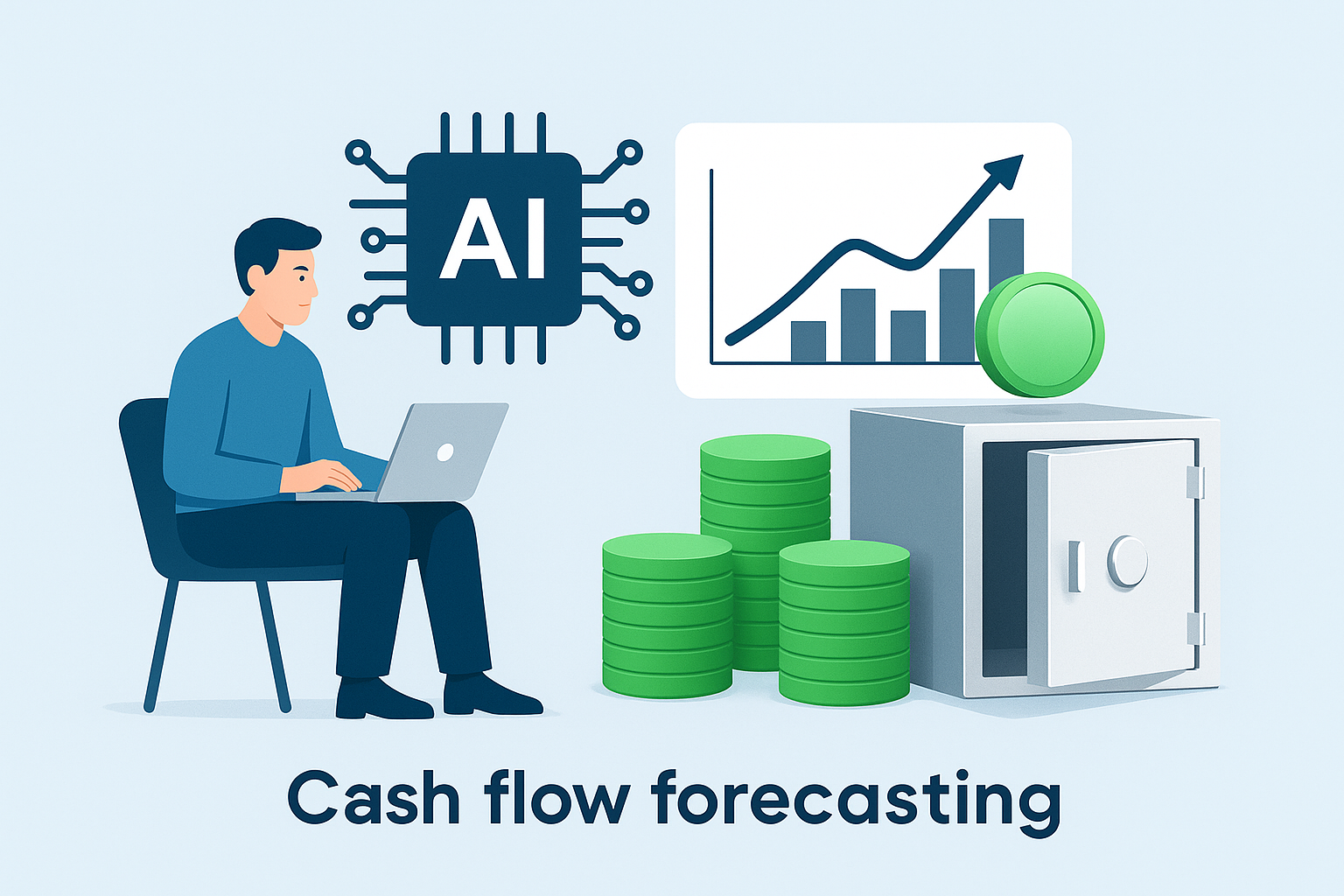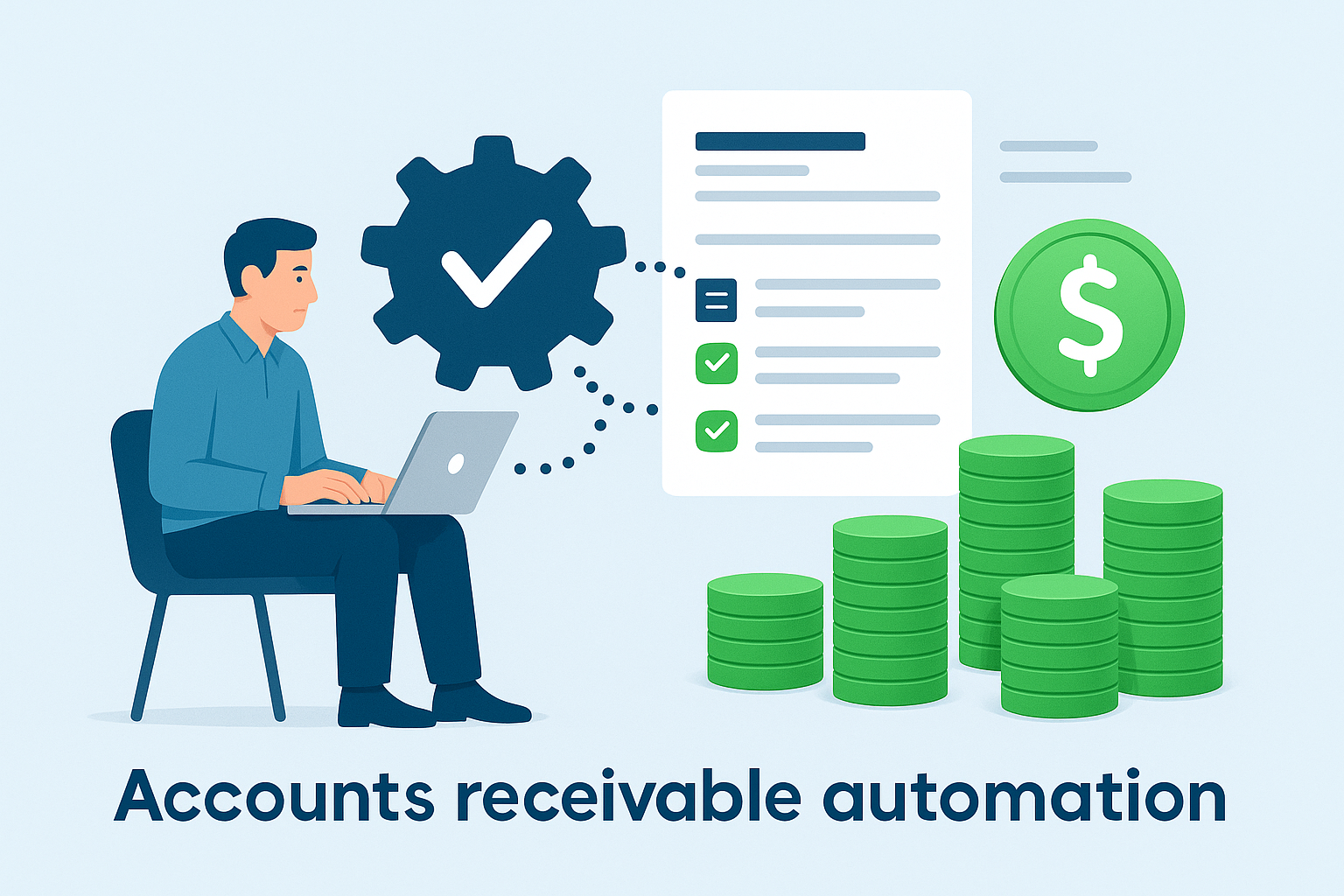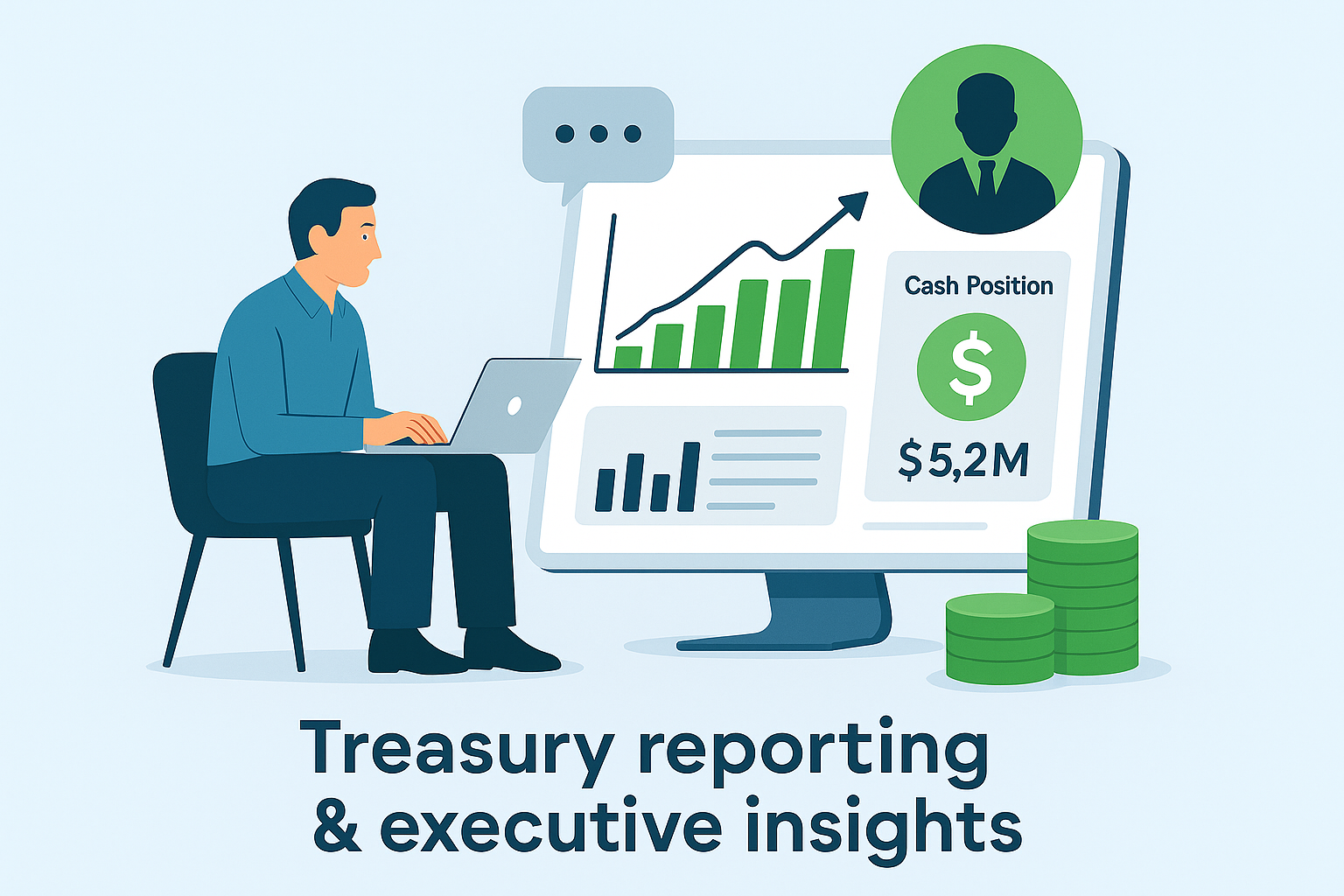TreasuryTech: AI vs. traditional solutions
Let’s explore real-world examples of how AI is making a measurable impact in treasury for cash flow forecasting, AR automation and reporting. You’ll see under what conditions AI works best and when standard automation methods might be the better choice.

Case 1: Cash flow forecasting
Combining statistical models with AI for a smarter approach
Let’s start with the cash flow forecasting use case — one of the most critical and in-demand tasks for treasury teams, as ensuring liquidity is vital, and the right tools can make all the difference.
We’ll explore how traditional methods and AI can work together to create a smarter, more effective approach.
Most companies rely on historical trends and time-series forecasting — like ARIMA or regression — to project future cash flows. These methods are based on statistics and may include some of the basic machine learning approaches.
Another standard practice to keep forecasts current is rolling forecasts — they are updated periodically, often using integrations with ERP systems and bank data feeds. Also, many treasury teams rely on Excel for scenario modeling, manually adjusting assumptions to test different outcomes. This is a common reality, even in organizations with advanced tools.
When statistical forecasting works well
Statistical forecasting is reliable when business patterns are stable and historical data is consistent. This method works well as the forecasts are clear and easy to explain, which builds trust with stakeholders; it’s straightforward to implement with existing tools like ERPs or TMS systems.
And statistical forecasting is often the best approach indeed, as:
- Actually most companies already have the data needed for time-series forecasting.
- For short-term forecasting — like 1 to 3 months — historical data is often sufficient without the complexity of AI.
- Treasury teams appreciate its predictability and transparency.

When AI steps in
However, AI can make a difference in more complex environments, when cash flows are unpredictable — think acquisitions, market volatility, or international expansion:
- It can analyze external factors that traditional models ignore, such as economic conditions, interest rates, and inflation trends; customer behavior patterns and supplier performance; inventory turnover and logistics data that impact working capital.
- Instead of relying only on historical averages, AI can analyze live transaction data, making forecasts more dynamic and accurate.
- There is an issue of addressing underutilized data: many businesses collect valuable data (like sales pipelines, production cycles, or supplier shipments) that impacts cash flow — but it often goes unused because it’s too labor-intensive to process manually, and it becomes outdated before it’s ready for use. AI automates data extraction and pattern recognition, turning this data into immediate insights for forecasting.
So, AI’s impact in forecasting is evident:
- It provides higher accuracy by incorporating live data and external factors
- It detects anomalies and flags unexpected cash flow risks early
- It automates real-time scenario modeling instead of relying on static spreadsheets
In many cases, we’d recommend a combination of both approaches to take the best of both worlds. Use statistical models for baseline forecasts, like short-term liquidity needs. And layer AI-driven insights — to refine accuracy, detect anomalies, and adapt to changing patterns. Leverage AI to process and incorporate external and operational data that is traditionally ignored due to manual effort.
Let’s sum it up:
Traditional statistical forecasting remains the foundation for treasury planning, but AI adds value when business conditions change, external influences are unpredictable, or real-time data needs to be analyzed at scale. A blended approach combines stability with adaptability, ensuring treasury teams make the most informed decisions.
Case 2: Accounts Receivable automation
Streamlining cash collection with AI
Automating Accounts Receivable (AR) processes is a prime area where technology can make a huge difference, but the choice between rule-based automation and AI depends on the complexity of your workflows.
How traditional automation works:
Teams use ERP and TMS integrations to match incoming payments to open invoices using structured fields like invoice numbers, customer IDs, and payment references. Automated payment reminders are triggered at set intervals to reduce overdue receivables. APIs enable banks to send remittance data, improving reconciliation accuracy and reducing manual effort.
The benefits of such approach include:
- Faster cash application for clear-cut payments.
- Reduced manual effort for reconciling structured payments.
- Efficient handling of most predictable transactions.

When AI steps in
While traditional automation handles the basics, AI steps in to tackle more complex challenges. It doesn’t replace traditional methods but enhances AR automation by categorizing, prioritizing, and analyzing data in ways that reduce manual effort and improve decision-making.
AI is particularly useful for handling edge cases, inconsistencies, and unstructured data — areas where traditional rule-based automation struggles.
- Edge cases
These are unusual or rare scenarios that don’t fit standard automation rules.
Here’s an example: Imagine that a customer submits a partial payment without clear remittance details. A rule-based system would fail to match it, but AI could analyze past transactions and suggest the most likely invoice match.
- Inconsistencies
This refers to variations in data formats, missing fields, or incorrect entries that can confuse rigid automation.
A good example is when a payment reference contains typos or a vendor uses different invoice numbers in emails vs. payment transfers, AI can identify patterns and help correct the mismatches.
- Unstructured data
As mentioned, rule-based automation works best with structured data (e.g., fixed fields in an invoice or payment file). However, we all know that much of treasury-related information comes from emails, PDFs, contracts, and free-text descriptions, which are unstructured and difficult for traditional systems to process.
Example in collections: AI-powered Natural Language Processing can scan customer emails to detect implicit payment terms (for instance, saying "We will process this invoice in 60 days as per our new vendor policy"), allowing treasury to adjust expectations accordingly.
There are three major reasons why traditional rule-based automation struggles with these issues:
-
Rule-based systems rely on predefined logic, meaning they fail if data doesn’t fit expected formats.
-
Such systems can’t "interpret" or adapt to patterns unless explicitly programmed.
-
While they excel at structured, repetitive tasks, they break down when faced with irregularities.
AI fills this gap perfectly.
It learns from past data and adapts to variations, making it well-suited for situations where:
- data is inconsistent or missing details,
- where information comes from unstructured sources like emails, PDFs, and contracts,
- and where decisions require context-awareness, rather than rigid rules.
What's very important is that AI’s role here is primarily supportive, as it doesn’t replace traditional automation but complements it by handling the unpredictable parts of treasury operations.
Now, where specifically AI adds value in Accounts Receivable processes:
-
Enhanced payment matching with pattern recognition
AI can suggest potential matches for incoming payments when key details are missing, such as incomplete remittance references or inconsistent invoice formats.
For example, AI learns patterns from past reconciliations and suggests the most likely invoice match for an ambiguous payment, reducing manual intervention.
-
Real-time data updates for payment risk assessment
While historical payment trends are best assessed using statistical methods, AI can integrate real-time transaction data and additional payer information to detect early signs of delayed payments.
Think of how AI flags a customer account that has recently disputed invoices or changed payment behavior, allowing treasury teams to act sooner.
-
Applying Natural Language Processing for email and contract analysis
AI can scan customer emails, contracts, and payment agreements to extract implicit payment terms, such as hidden net terms or unstructured early payment discount clauses.
Imagine a scenario where AI identifies that a specific customer consistently delays payments by citing contract clauses. This insight prompts the treasury team to review and adjust the agreement terms.
The impact of AI-driven AR support is invaluable:
- It speeds up exception handling by automatically categorizing and prioritizing complex payment issues.
- It reduces time spent on reconciliation, especially when remittance details are missing or inconsistent.
- It incorporates real-time updates into collection strategies, supplementing statistical risk assessments with new behavioral insights.
Let’s sum it up:
Traditional AR automation still remains the backbone of treasury operations, efficiently handling structured payments. At the same time AI serves as a supporting function, enhancing efficiency as it suggests payment matches, integrates real-time payer behavior data, and automates the review of unstructured contract details.
The best approach — as with forecasting — is also a hybrid model: use rule-based automation — for structured data, statistical models — for trend analysis, and AI — for handling inconsistencies, exceptions, and real-time updates.
Case 3: Treasury reporting & executive insights
From static reports to real-time AI-driven insights
Today, most treasury teams rely on static, rigid, and labor-intensive manual processes to compile cash position reports. Here’s how it typically works:
- Treasury teams pull data from multiple sources, including bank accounts and liquidity structures; ERP, TMS, and investment accounts; debt schedules, working capital reports, and cash forecasts.
- Cash position reports are built manually or through static dashboards, with predefined formats and little flexibility.
- The process lacks real-time adaptability — if a Treasurer or CFO wants additional insights, they must wait for the next reporting cycle or request manual adjustments.
Traditional reporting brings several challenges:
- No flexibility: Once reports are prepared, any new request requires a manual refresh.
- Limited visibility: Executives can’t drill down or run custom scenarios on demand.
- The data is often outdated by the time reports are reviewed, which is making it less useful for decision-making.
Here’s a quick example of current state.
Imagine the CFO receives a weekly cash report showing total liquidity and upcoming obligations. Suddenly, they ask: “How would our net cash position change if we accelerated a $10M supplier payment?”
The treasury team can’t answer immediately — they need to run new calculations, adjust working capital assumptions, and create a new report manually. Which is time-consuming and inefficient.

When AI steps in
There’s a specific solution for this challenge: the AI Treasury Assistant. This tool enables dynamic, on-demand reporting. Let’s break down how it operates.
- AI connects to all your data sources — including ERP, TMS, banking platforms, debt schedules — and can respond to ad-hoc executive questions instantly.
- Therefore, treasury no longer needs to anticipate every reporting need — the AI assistant can generate real-time insights on request.
- For pre-defined SQL inquiries, AI can also run complex calculations, apply treasury logic, and model different cash flow scenarios on the fly.
What's next
AI doesn’t drive results in treasury on its own. It needs the right environment and foundation to deliver real value. And building that foundation is often the hardest part. Before launching an AI initiative, treasury teams need to align on goals, prepare their data, processes, and people. It may seem complex or risky — but with a structured approach, it becomes manageable and clear.
That’s what we’ll cover in the next part — how to build a strong foundation for AI. Stay tuned!















